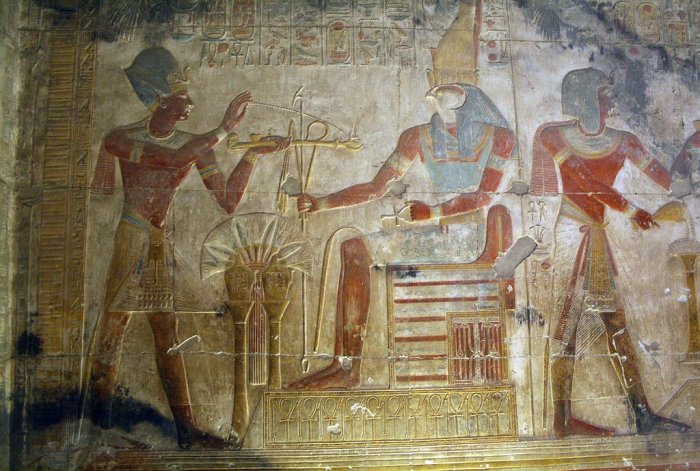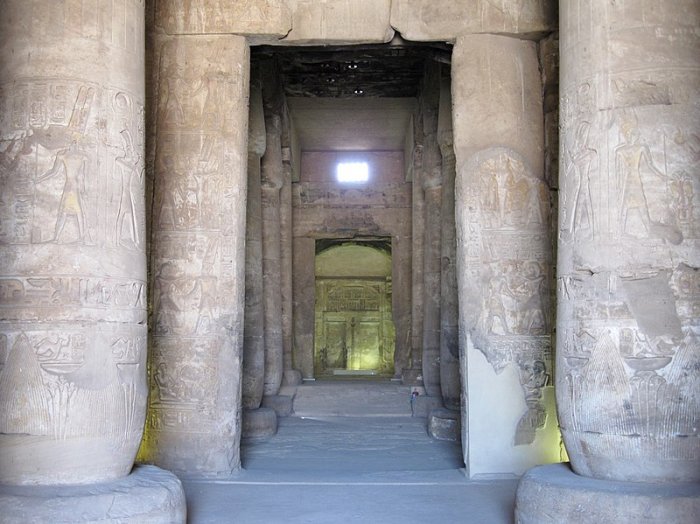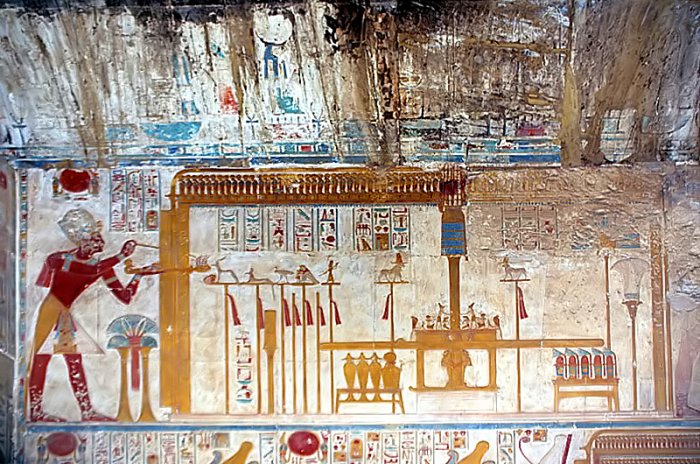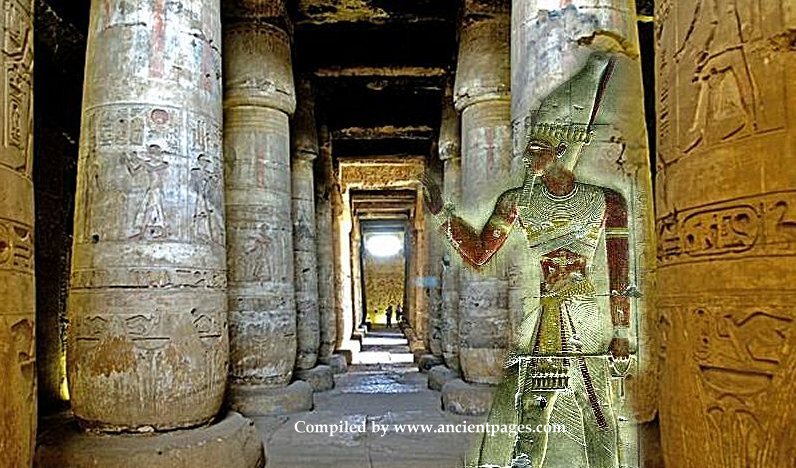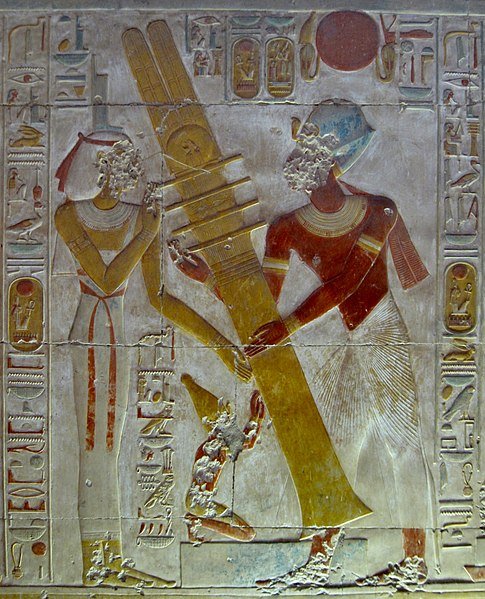Abydos: One Of The Most Important Cities Of Ancient Egypt
A. Sutherland - AncientPages.com - Once, it was the site of many temples, especially the temple of Seti I, and first of all, this very ancient city is strongly associated with the "Lord of Abydos" - Osiris, god of the dead and its cult.
Temple of Osiris at Abydos. God Horus presents royal regalia to a worshipping pharaoh. Credit: Steve F-E-Cameron - CC BY-SA 3.0
Today, it's considered one of ancient Egypt's most important archaeological sites. It is a place with a famous royal necropolis where early pharaohs were entombed and other tombs and mortuary cult enclosures of the rulers of the First Dynasty.
According to some ancient mortuary texts, beyond a gap in the mountains to the west of Abydos lay the afterlife, a fantastic realm depicted as a long mountainous valley with a river running through it, the banks lined with wheat fields, fruit orchards, and gardens of flowers.
Many of these tombs are still buried under the desert sands. They keep millennia-old secrets of the sacred ground of Abydos, which flourished and was already surrounded with an aura of sanctity.
Abydos Temple. Credit: Olaf Tausch - CC BY 3.0
Otherwise, these archaeological treasures could cast light on the origins of the Egyptian civilization, still a controversial subject among many scholars.
Abydos rose to its peak as a holy city during the New Kingdom (1567- 1080). Still, the rising local cult of the "Lord of Abydos" lasted at least from the Middle Kingdom (around 1800 BC) until late Antiquity and the tomb of Osiris was the main focus of worship.
Today, the Abydos Temple is notable for the memorial temple of Seti I, which contains an inscription from the nineteenth Dynasty known to the modern world as the Abydos King List.
It is a chronological list showing cartouches of most dynastic pharaohs of Egypt from Menes until Ramesses I, Seti's father.
Abydos is the source of many of Egypt's most ancient artifacts. Unfortunately, the Great Temple of Abydos and most ancient towns are buried under the modern buildings to the north of the Seti temple.
Many of the original ancient structures and artifacts are considered irretrievable and lost.
Chapel of Osiris, King censing before shrine containing Osiris emblem, Temple of Seti I, Abydos, Egypt. Credit: Roland Unger - CC BY 3.0:
In archaeology, many extraordinary finds still make headlines either because of their prehistoric significance - many priceless artifacts witnessed the glory of Abydos - or even because of the sensational circumstances surrounding them.
In 1988 Günter Dreyer, a German archaeologist, unearthed small bone and ivory tags intricately inscribed with one of the world's earliest forms of writing, namely, crude hieroglyphs developed at about the same time as Mesopotamian cuneiform.
"Each discovery raises new questions and issues and indicates that further mysteries remain to be explored and resolved," said David O'Connor, an internationally recognized Egyptologist with 40 years experience of excavation and research at Abydos and author of "Abydos: Egypt's First Pharaohs and the Cult of Osiris."
In 1991, O'Connor uncovered an eerie fleet of wooden boats buried in enormous brick-lined graves: how many more priceless artifacts are hidden under the desert sand?
Abydos and its sacred ground are famous for its two fine temples, one built by Seti I, who encouraged artistic and architectural ideas in his reign. The other was by Ramses II, although by no means his most extensive and well-preserved.
Once upon a time, this structure must have been among the most beautiful in the Nile Valley, but there is much more to find in the most sacred cities - Abydos.
Many secrets of Abydos are still waiting to be discovered.
In the 19th Dynasty, the site and its chief deity were honored by Seti I, who ruled Egypt from 1313 to 1292 B.C. The three gods of the Osirian Triad (Osiris, his wife Isis, and son Horus) were raised to an even higher level than the greatest gods of the Land of the Pharaohs - Ptah of Memphis, Re-Harakhte of Heliopolis, and Amun-Re of Thebes.
A scene from the Hall of Osiris at Abydos shows the raising of a djed pillars, a symbol of stability. Credit: Olaf Tausch - CC BY 3.0
An impressive temple of Kom Al-Sultan was constructed, with separate sanctuaries for each deity and the seventh chamber of equal size to himself as a god. Why?
For example, what happened to the earliest shrine at Abydos, dedicated to the Jackal God of Abydos - Wepwawat ("the opener of the ways (or Roads)" - the wolf-jackal of the graveyard?
"Abydos will continue to intrigue archaeologists, Egyptologists, and lay enthusiasts for many generations to come," said O'Connor.
Written by – A. Sutherland AncientPages.com Staff Writer
Updated on October 23, 2022
Copyright © AncientPages.com All rights reserved. This material may not be published, broadcast, rewritten or redistributed in whole or part without the express written permission of AncientPages.com
More From Ancient Pages
-
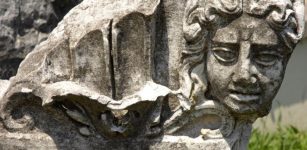 Ancient City Of Prusias ad Hypium And Ruins Of City’s Theater Known As ’40 Steps’
Archaeology | Mar 13, 2020
Ancient City Of Prusias ad Hypium And Ruins Of City’s Theater Known As ’40 Steps’
Archaeology | Mar 13, 2020 -
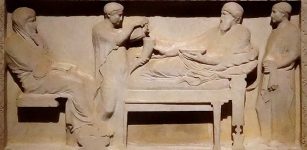 Who Were The Satraps Of The Achaemenid Empire?
Featured Stories | Aug 28, 2021
Who Were The Satraps Of The Achaemenid Empire?
Featured Stories | Aug 28, 2021 -
 The Phoenicians – And Their Great Experience As Sea Traders
Civilizations | Sep 6, 2015
The Phoenicians – And Their Great Experience As Sea Traders
Civilizations | Sep 6, 2015 -
 Strange Case Of A Victim Who Solved Her Own Murder – Unusual Powers Of The Human Mind
Featured Stories | Feb 15, 2019
Strange Case Of A Victim Who Solved Her Own Murder – Unusual Powers Of The Human Mind
Featured Stories | Feb 15, 2019 -
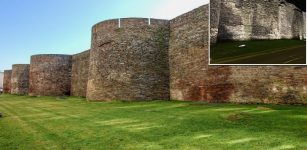 Walls Of Lugo: Finest Example Of Late Roman Fortifications – Stands The Test Of Time
Featured Stories | Sep 22, 2022
Walls Of Lugo: Finest Example Of Late Roman Fortifications – Stands The Test Of Time
Featured Stories | Sep 22, 2022 -
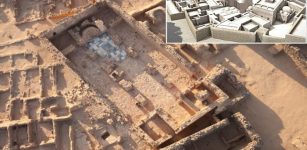 Virtual Nubia: Sudan’s Medieval Monasteries Digitally Reconstructed By Polish Archaeologists
News | Oct 8, 2020
Virtual Nubia: Sudan’s Medieval Monasteries Digitally Reconstructed By Polish Archaeologists
News | Oct 8, 2020 -
 Ancient Secrets Of The Amazon Jungle – The Man Who Stepped Into The Unknown Searching For The Lost City Of The Gods – Part 2
Featured Stories | Mar 5, 2019
Ancient Secrets Of The Amazon Jungle – The Man Who Stepped Into The Unknown Searching For The Lost City Of The Gods – Part 2
Featured Stories | Mar 5, 2019 -
 Griffins Were Mythical Gold-Guarding Hybrid Creatures Known For At Least 5,000 Years
Ancient Symbols | Mar 9, 2021
Griffins Were Mythical Gold-Guarding Hybrid Creatures Known For At Least 5,000 Years
Ancient Symbols | Mar 9, 2021 -
 Ancient Secrets Of The Nine Unknown Men: Guardians Of Forbidden Knowledge Hidden From Humanity
Featured Stories | Aug 28, 2014
Ancient Secrets Of The Nine Unknown Men: Guardians Of Forbidden Knowledge Hidden From Humanity
Featured Stories | Aug 28, 2014 -
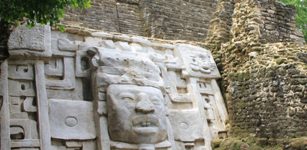 Lamanai, Belize: One Of The Largest And Oldest Maya Cities Dated To 1500 BC
Civilizations | Nov 2, 2018
Lamanai, Belize: One Of The Largest And Oldest Maya Cities Dated To 1500 BC
Civilizations | Nov 2, 2018 -
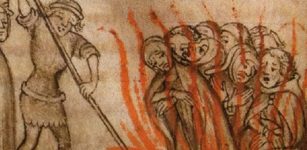 On This Day In History: Knights Templar Arrested – Oct 13, 1307
News | Oct 13, 2015
On This Day In History: Knights Templar Arrested – Oct 13, 1307
News | Oct 13, 2015 -
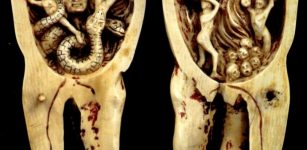 ‘The Battle Of The Tooth Worm’ – Strange Ivory Carving
Artifacts | Aug 11, 2015
‘The Battle Of The Tooth Worm’ – Strange Ivory Carving
Artifacts | Aug 11, 2015 -
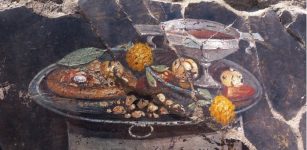 Ancestor Of Italian Pizza Depicted On Fresco In Pompeii
Archaeology | Jun 28, 2023
Ancestor Of Italian Pizza Depicted On Fresco In Pompeii
Archaeology | Jun 28, 2023 -
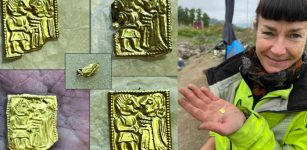 Mysterious Tiny 1,400-Year-Old Gold Foil Figures Found In Pagan Temple
Archaeology | Sep 23, 2023
Mysterious Tiny 1,400-Year-Old Gold Foil Figures Found In Pagan Temple
Archaeology | Sep 23, 2023 -
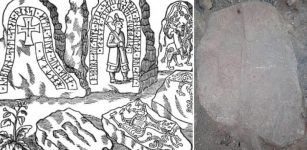 Unique Lost Runestone Of The Hunnestad Monument Finally Found After 300 Years In Sweden
Archaeology | Dec 16, 2020
Unique Lost Runestone Of The Hunnestad Monument Finally Found After 300 Years In Sweden
Archaeology | Dec 16, 2020 -
 Kobold: Mythological Spirit Of Underground: Guardian Of Miners And Earth’s Treasures
Featured Stories | Jun 13, 2016
Kobold: Mythological Spirit Of Underground: Guardian Of Miners And Earth’s Treasures
Featured Stories | Jun 13, 2016 -
 Homo Longi: Extinct Human Species That May Replace Neanderthals As Our Closest Relatives
Evolution | Sep 14, 2023
Homo Longi: Extinct Human Species That May Replace Neanderthals As Our Closest Relatives
Evolution | Sep 14, 2023 -
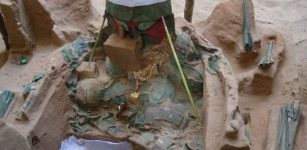 Tomb Of A 1,000-Year-Old Sican Surgeon Wearing A Golden Mask Discovered In Peru
Archaeology | Mar 30, 2022
Tomb Of A 1,000-Year-Old Sican Surgeon Wearing A Golden Mask Discovered In Peru
Archaeology | Mar 30, 2022 -
 Bronze Age Royal Tombs Unearthed In Ruins Of Ancient City Of Pylos, Greece
Archaeology | Dec 30, 2019
Bronze Age Royal Tombs Unearthed In Ruins Of Ancient City Of Pylos, Greece
Archaeology | Dec 30, 2019 -
 Is There An Over-Looked Ancient Secret In Sahara?- Intriguing Theory Examined
Featured Stories | Jul 30, 2019
Is There An Over-Looked Ancient Secret In Sahara?- Intriguing Theory Examined
Featured Stories | Jul 30, 2019

